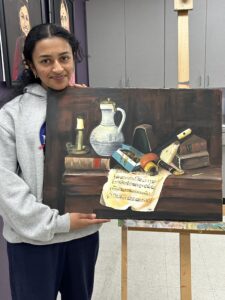Hand Dexterity still relevant for highly specialized professions

Hand or Manual dexterity is the ability to use your hands in a skillful, coordinated way to grasp and manipulate objects and demonstrate small, precise movements. As per Dr. Roger Kneebone about a worrisome issue affecting medical students in the UK: They show a lack of hand dexterity in simple tasks such as tying knots and cutting string. Hand dexterity is a critical skill for surgeons, yet “It seems we can no longer rely on people having developed these ways of using their hands from early childhood, at home, and at school,” ( https://activeforlife.com/developing-hand-dexterity-in-early-years-essential-for-adulthood/) Experts have suggested that this ineptitude in fine motor skills among the current generation of emerging clinicians and many more professionals may be due to less exposure to knowledge and learning that require practical drawing and craft skills in primary and secondary schools. Dr. Rhea Liang, MBChB, an Associate professor of Surgery specializing in breast cancer at Gold Coast Hospital and Health Service in Robina, Australia, does “wool craft” during lectures to help her listen to and recall information. (The ‘Knitting Lady’ Is a Surgeon and She’s Paying Attention “Unlike Phones, Handiwork Does Not Distract” by-Nick Mulcahy, August 12, 2019, https://www.medscape.com/viewarticle/916712) At present increasing numbers of young kids are just using a keyboard for 90% of their work. they hardly use their thumb for their academic tasks. Using hand and handheld tools for Geometry, Art, writing skills focus on cursive writing, hand embroidery is, becoming obsolete and are no longer mandatory either in schools or at home as a part of the personality growth. Regardless of ability, activities, and skills that focus on dexterity and fine motor skills are important because they help students increase the muscles in their fingers, hands, and wrists, while also increasing coordination. Engaging in skills like embroideries, sewing, cutting, painting, drawing in early life does not necessarily mean that you are going to be a fashion or textiles designer, or, professional in a related field. But, it nurtures your ability to become efficient in certain skills that require high precision, hand-eye coordination, and application of fine motor skills like performing surgery, as quoted earlier. More and more schools are looking into these abilities apart from your perfect score in your academia. Yes! The Dental Admission Test (DAT) contains a section that specifically tests this skill, and during on-campus interviews, most dental school admissions staff will ask you to discuss how you’ve developed your manual dexterity skills. At Kalaa You will get the opportunity to nurture this part of your persona and will help to engage the students creatively and refine their needed skills for the future. These developed portfolios can be used towards college admission : Art Portfolio (3 years Learning skills culminating to Art Portfolio for school admission as Extracurricular activity for a length of time) Painting Exhibition Foundation of Textiles and Fashion Design (2 years Designing/ pattern development/sewing)Needlecraft (2 Years) Blog writing to support your comprehension skills and explanatory ability As the 🌎 stops, hit the gas on! Building your art profile getting access to a unique, personalized training that will bring out the best in you! Shelter in Place, Social distancing is the key! Stay safe, keep your spirits high! Online classes for #Art and #Design Portfolio development for c
Art for improving Hand Dexterity for Children

“The hands are the instruments of man’s intelligence”, – Maria Montessori. children’s dexterity is so important in their education and for their overall development. art has great role to play in this regard. Arts helps in refining hand dexterity help children develop their cognitive, social and motor abilities. Art plays major role in developing following areas: Cognitive abilities: Art teaches students that mistakes are alright and not end of the problems but can be redone. Art induces the mind to discover. It teaches young minds that any problem may have more than one solution. Art gives learning and the power to make their ideas come true through materials Social abilities: Teach them that they have to endure efforts. It nurtures the social skill that they should value the efforts of others. Art study works as therapies for children with difficulties. Creative processes are a way to create an integration in groups with various cultures. Motor skills: Fine motor skills are those that involve a refined use of the small muscles which control the hand, fingers, and thumb. Handling a pencil or brush correctly, using glue to stick, paper, feathers, glitter, and the like on a mask and drawing improve the children’s dexterity and their use of objects in a controlled way. It is an excellent way to develop eye-hand coordination. Any activities that include crafts or playing with loose parts will help kids develop hand dexterity. Every art lesson in Kalaa is created keeping the development of the child’s social, cognitive, emotional, and physical development in mind. The skills developed during the process of creating art will enable your child to meet with future success in school and life.










